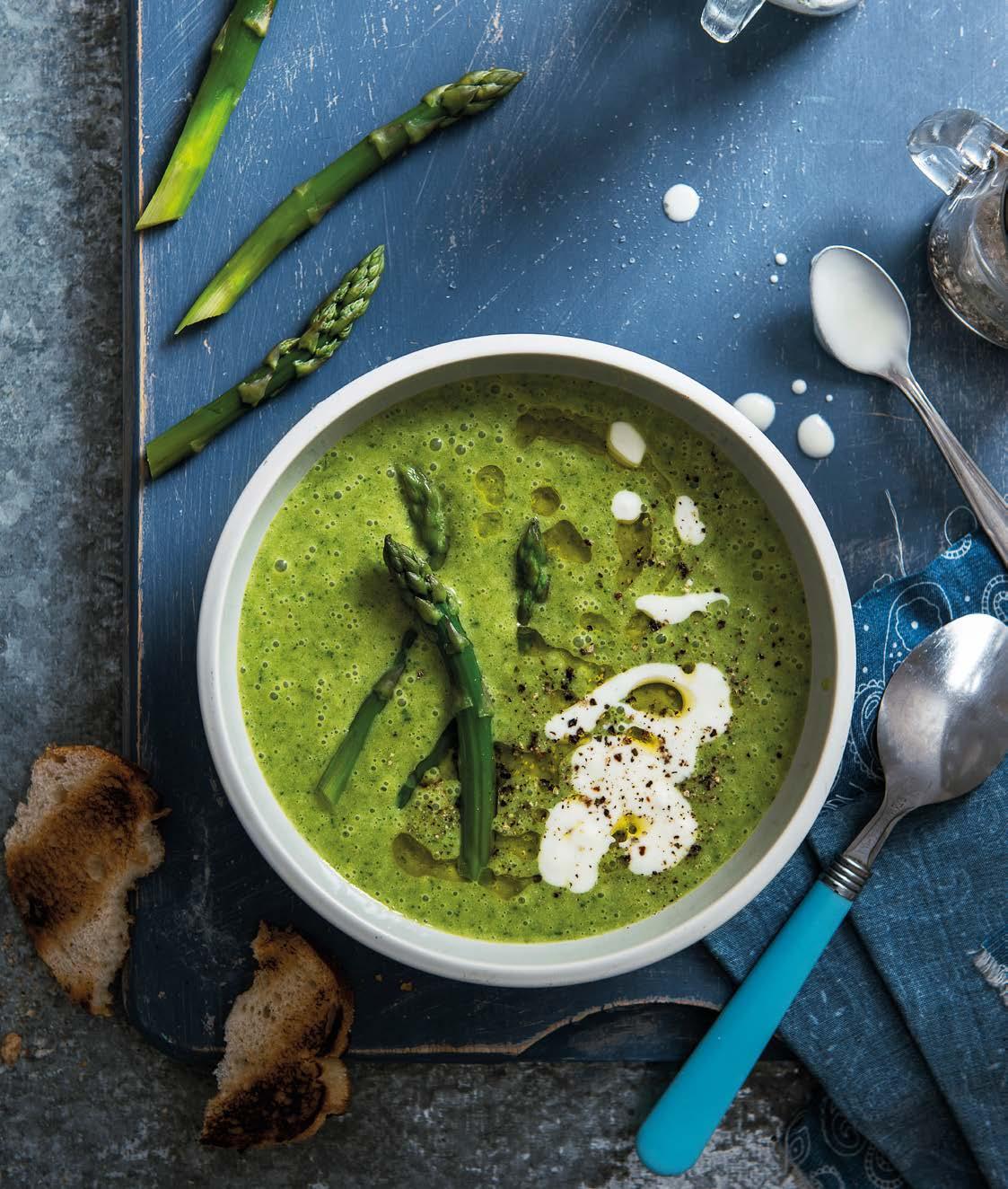
4 minute read
FROM PATCH TO PLATE: MATTHEW FORT Our food
MY ENGLISH HOME Matthew Fort FROM PATCH TO PLATE
The food writer and critic tells of his excitement for the produce to come in his burgeoning vegetable beds and the sings the praises of asparagus in its many varieties
‘I t’s been the most beautiful spring I can remember. Pretty much unbroken sunshine except for the odd rainy day.’ So said my garden diary this time last year.
Ah, the joys of the vegetable bed, even in the time of lockdown. The hope, the joy, the simple pleasure and modest pride in the early produce as spring slides seamlessly into summer. The smell of cut grass, blossom on the fruit trees, the murmur of bees, and the seduction of asparagus.
Nothing quite symbolises early summer to me than asparagus. The wild and curious flavour of those slender, green spears erupting from the earth. Bright green, naturally. The Belgians, French and Germans may favour the white asparagus, but in my view it’s not in the same league as our own emerald green spears. I say ‘our’, but strictly speaking asparagus isn’t ours. According to learned authorities, wild asparagus – asparagus officinalis – migrated westwards from Poland and Russia back in the day. The Romans cultivated it, as, a bit later, did the Moors, who helped spread the word about this most aristocratic of vegetables.
Asparagus reached England in 1638 and we took to it with enthusiasm. It reached the Americas a little later, as it was popularised by that energetic polymath and devoted vegetable grower, Thomas Jefferson, who grew it in large quantities in his garden at Monticello.
Modern varieties go by such names as ‘Aspalim’, ‘Darlise’, ‘Gijnlim’ and ‘Guelph Millenium’, that speak of cutting-edge hybridisation from the garden research centres of New Zealand, Holland and the USA. These varieties may be productive and regular in shape, but, call me oldfashioned, they simply don’t have the magic (or the flavour) of traditional varieties such as that Victorian favourite, ‘Connover’s Collosal’, the great American asparagus, ‘Mary Washington’, or ‘Violetto d’Albenga’, Italy’s very own heirloom purple asparagus.
Sadly, I don’t grow asparagus myself. I simply don’t have enough space to let a large bed lie unused for much of the year, but I grew up with asparagus beds as a child. It was one of those seasonal treats – a few weeks of gorging ourselves on these mysteriously delectable spears slathered in butter.
These days, the asparagus season has been extended by the judicious use of polytunnels, and I anxiously wait for the first bundles to appear in Stroud Farmer’s Market. I check the cut ends to make sure they’ve been picked that morning, or possibly the day before. If they look too dried out or show signs of shrinking up the stems, I pass on by, as asparagus is one of those vegetables that, like potatoes, are transformed by being cooked and eaten as soon as possible after picking.
So, having got them home, what then? If you’re a die-hard traditionalist, you’ll boil or steam them in a special upright asparagus pan, and then bathe them in melted butter, or hollandaise sauce if you’re being really sophisticated. However, now that asparagus has become a vegetable of the people, sometimes I roast them (about 10 minutes at 160°C), or fry them in butter (10 minutes again), or char them on a griddle pan.
If you’ve ever steamed or boiled asparagus, you’ll have been aware of how the water smells and tastes of the vegetable, which means you’ve lost that essence. Roasting or frying in olive oil or butter means any juices lost by the spears go into the oil or butter and are not lost. I then shave Parmesan over them; incorporate them into frittatas; make a ristotto; or dip them into a soft-boiled egg instead of soldiers. In other words, eat them as fast as decency allows.
About Matthew Best known as a judge on BBC2’s Great British Menu, Matthew is an award-winning food writer and critic. He was the Food & Drink Editor of The Guardian for 15 years and is the author of four books.
ASPARAGUS & PEA SOUP WITH CRÈME FRAICHE & MINT
Serves 4
INGREDIENTS
500g asparagus 300g peas (fresh or frozen) 500 ml vegetable stock A sprig or two of mint 150 ml creme fraiche Extra virgin olive oil Salt and white pepper
METHOD
• Bend each of the asparagus spears until they snap. Put the vegetable stock in a pan and bring to the boil. Add the bottom sections of the snapped asparagus and leave until they are cooked through (about 5–8 minutes). • Strain the vegetable/ asparagus stock into a fresh
pan. Plunge 400g of the asparagus tops into the stock along with the peas. Cook for 4 minutes. Add the mint sprigs and them leave to steep for a minute or two. • Purée the asparagus, peas, mint and stock to a smooth, velvety liquid. Season with salt and white pepper. Cut the remaining asparagus tops
in half lengthways and fry in the olive oil until tender. • Ladle the soup into four soup plates or bowls and drizzle the olive oil from the frying pan over them. Pop a dollop of crème fraiche on each and arrange the fried asparagus at random on top. (This soup can also be served cold). n











